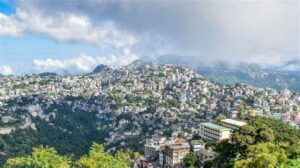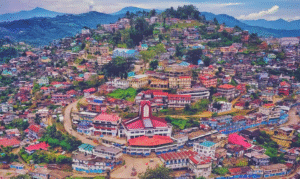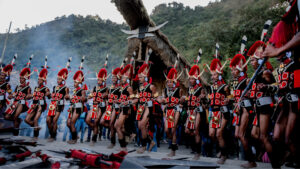Introduction
India’s diverse cultural tapestry is deeply interwoven with nature, agriculture, and tribal heritage. Among its many regional festivals, Garia Puja stands out as a vibrant and meaningful celebration, primarily observed by the Tripuri tribes and other indigenous communities in the state of Tripura, located in Northeast India. Rooted in agrarian life and tribal belief systems, Garia Puja is a springtime festival that is dedicated to Garia, the deity of livestock, prosperity, and good harvest.
Held annually in the month of Baisakh (April), this festival marks the beginning of the sowing season. As such, it is not only a religious ritual but also a communal prayer for abundance and fertility of the land. With traditional dances, songs, prayers, and offerings, Garia Puja is a celebration of both nature and identity—an expression of tribal reverence for the earth and its resources.
Historical and Cultural Background
Tripura has a rich tribal population, and its culture has evolved around nature worship and animistic traditions. Among the 19 recognized tribes in Tripura, the Tripuri, Reang, Jamatia, and Noatia tribes hold Garia Puja in high esteem.
The Garia deity is often associated with fertility, livestock, harvest, and general well-being. The origin of the festival can be traced back to tribal agricultural practices when communities depended entirely on the land for survival. Garia Puja thus serves a dual purpose: appeasing the spirits believed to govern agriculture and reinforcing community bonding through ritual and festivity.
The practices surrounding Garia Puja also underscore the intimate relationship between humans and nature in tribal philosophy. It emphasizes sustainability, gratitude, and harmony with the environment—concepts that hold increasing relevance in today’s climate-sensitive world.
Timing and Duration of the Festival
Garia Puja is celebrated annually on the seventh day of Baisakh, which typically falls in mid-April, just after the conclusion of the Bengali New Year. This timing is not coincidental—it aligns with the end of jhum (shifting) cultivation preparations and the onset of the sowing season.
The celebration generally lasts for seven days, culminating in a final day of rituals, performances, and community feasting. Each day during this week carries its own significance, with some days set aside for preparing offerings, others for community dances and rituals, and the last day for concluding rites.
Rituals and Worship Practices
At the heart of Garia Puja is the ritualistic worship of the bamboo pole, representing the Garia deity. This bamboo is usually installed in a sacred area, often inside or near the village courtyard. It is adorned with flowers, cotton threads, rice beer, and garlands, symbolizing nature’s gifts and tribal aesthetics.
Key elements of the ritual include:
- Invocation of Garia: A priest known as the ‘Ochai’ (tribal priest) begins by invoking Garia using chants and traditional offerings. He seeks the god’s blessings for a prosperous season and protection against natural calamities or diseases.
- Animal Sacrifices: Traditionally, cock sacrifices are an integral part of the ritual. The cock is considered a sacred messenger to the gods and is believed to carry the prayers of the people. This ritual signifies the depth of tribal belief in sacrificial offerings as a medium of communication with the divine.
- Rice Beer and Local Liquor: Homemade rice beer, known as ‘Chuak’, is offered to the deity and later shared among the villagers as a sign of divine blessing and community unity.
- Offerings: Items like rice, eggs, cotton, coins, and vegetables are offered to Garia. Each of these represents essential elements of tribal livelihood—rice for food, cotton for clothing, eggs for fertility, and so on.
- Prayer for Livestock: Along with harvest, prayers are also offered for the well-being of livestock—cows, goats, pigs, and chickens—which are vital to tribal economy and sustenance.
Dance, Music, and Community Participation
No tribal festival is complete without dance and music, and Garia Puja is no exception. Cultural performances play a crucial role in both the ritual and the celebratory aspects of the festival.
- Garia Dance: Young boys and girls dressed in colorful traditional costumes perform the Garia dance, which is perhaps the most iconic element of the festival. Accompanied by drums, flutes, and bamboo percussion instruments, the dancers move in rhythmic formations, invoking joy and spiritual fervor.
- Folk Songs: The songs performed during Garia Puja often narrate stories of agricultural life, romantic ballads, and tales of tribal ancestors. These oral traditions help preserve cultural memory and intergenerational knowledge.
- Drumming and Instruments: Instruments like the ‘Sumui’ (flute), ‘Kham’ (drum), and ‘Sarinda’ (string instrument) add to the celebratory mood, making the experience deeply immersive and communal.
Symbolism and Deeper Meaning
Garia Puja may appear to be a simple harvest festival, but it holds profound symbolic meaning for the tribal communities of Tripura:
- Reverence for Nature: The festival underscores a worldview in which humans are not separate from nature but part of a continuous ecological cycle. This is evident in the choice of natural items used in rituals—bamboo, flowers, feathers, and grains.
- Community Unity: The collective nature of the festival—where every household participates, offers, and celebrates—reinforces social bonds and tribal solidarity.
- Spiritual Ecology: Garia Puja illustrates what scholars call “spiritual ecology”—the idea that spiritual practice is inherently tied to environmental stewardship.
- Cultural Continuity: In a rapidly modernizing world, Garia Puja serves as a conduit for preserving tribal language, oral history, costume, and identity.
Regional Variations
While the central essence of Garia Puja remains consistent across Tripura, there are slight variations in its celebration among different tribes:
- The Reang community may include additional rituals involving forest spirits.
- The Jamatia tribe often conducts extended communal dances lasting late into the night.
- In urban areas, Garia Puja is sometimes performed in cultural halls or community centers with symbolic rather than sacrificial rituals due to ethical and legal constraints.
These variations reflect the adaptability of the festival and its ability to remain relevant across different geographic and social contexts.
Garia Puja in Modern Times
As Tripura becomes increasingly urbanized and influenced by mainstream culture, the traditional form of Garia Puja faces new challenges. However, efforts have been made by tribal organizations, cultural preservation bodies, and educational institutions to document, promote, and celebrate the festival as part of the region’s intangible cultural heritage.
- Government Recognition: Garia Puja has been recognized as a state-level festival, and public holidays are declared in its observance.
- Educational Inclusion: Schools and colleges in Tripura often organize cultural programs and workshops to teach students about the festival’s significance.
- Media Representation: Local television and radio stations broadcast special features, documentaries, and interviews with tribal elders during Garia Puja week.
Despite modernization, Garia Puja continues to be a marker of tribal pride and resilience.
Socio-Economic Significance
Apart from its religious and cultural dimensions, Garia Puja has important socio-economic implications:
- Seasonal Transition Marker: It helps the community mark the end of one agricultural phase (preparation) and the beginning of another (sowing), enabling synchronization of labor and resources.
- Livelihood Celebration: By focusing on harvest and livestock, the festival celebrates the backbone of the tribal economy and encourages sustainable practices.
- Cottage Industries: During the festival, traditional handicrafts, clothing, and food items are sold in village fairs and markets, supporting local artisans and farmers.
Conclusion
Garia Puja is more than just a festival—it is a living tradition that encapsulates the symbiotic relationship between humans and nature. For the tribal communities of Tripura, it is a time of joy, unity, devotion, and hope. As an agrarian festival, it prays for a good harvest and livestock prosperity; as a cultural ritual, it preserves tribal identity; and as a spiritual observance, it reconnects communities with the earth and their ancestors.
In a global climate where indigenous cultures are at risk of erosion, Garia Puja stands as a shining example of sustainable celebration and cultural endurance. For scholars, environmentalists, and cultural enthusiasts alike, it offers valuable insights into how traditional knowledge systems and eco-spiritual practices can inform our future.






